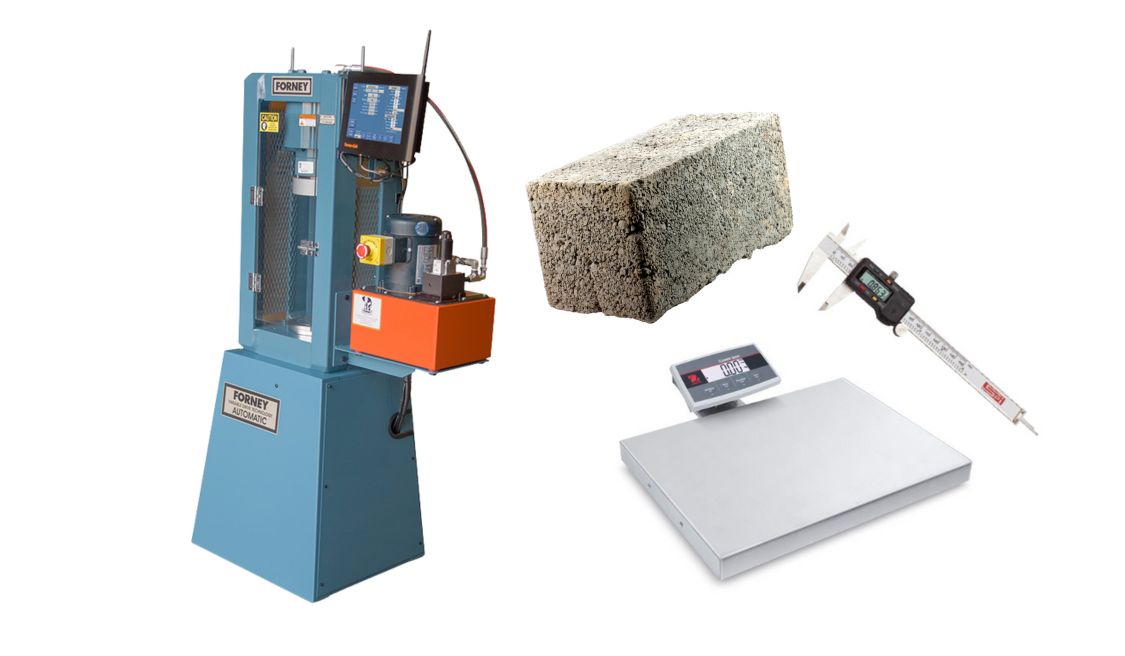Concrete ballast is an important construction material commonly used to provide stability in rooftops. ASTM C1884 covers the standard test method for two different types of manufactured concrete ballast units.
A concrete ballast is a heavy material that is strategically placed in a structure to provide stability. Rooftops and rooftop equipment often require concrete ballast to prevent displacement due to wind. This typically involves concrete ballast blocks and concrete roof pavers.
Concrete ballast blocks are used to anchor rooftop equipment such as HVAC units and solar panels to the roof to ensure the equipment stays securely in place.
Concrete roof pavers are a type of paving unit designed for flat roofs, creating a durable and functional surface. The weight of concrete roof pavers helps anchor the roof system, preventing wind uplift. It also helps to protect roof membrane.
In this article, we cover the basics of the standard specification for concrete ballast, including:
- The Importance of ASTM C1884
- What Happened to ASTM C1491?
- Recommended ASTM C1884 Equipment
- Test Procedure and Results
The Importance of ASTM C1884 for Concrete Ballast Units
C1884 is an important specification that ensures concrete ballast blocks and concrete roof pavers provide sufficient weight and stability to rooftops.
Concrete ballast blocks are manufactured with dry-cast concrete to meet specific weight requirements. Dry-cast concrete blocks are formed using a dry mix of concrete ingredients without excess water, resulting in a dense and durable product.
Traditionally, ASTM C1884 was the standard specification for only concrete ballast blocks. However, today the standard now applies to concrete roof pavers.
What Happened to ASTM C1491?
ASTM C1491 was the standard specification for concrete roof pavers for ballast and roof membrane protection. However, the specification was very similar to ASTM C1884, causing confusion in the construction materials testing industry.
To clear up the confusion, ASTM consolidated ASTM C1491 and ASTM C1884 into ASTM C1884-23, Manufactured Concrete Ballast Units.
To satisfy ASTM C1884 test requirements, you will need concrete testing equipment outlined below.
Recommended Equipment for ASTM C1884
Concrete ballast units must be tested for compressive strength, absorption, density, oven-dry weight, and dimensional tolerances according to ASTM C140.
- Caliper to measure dimensions
- Water container to immerse the concrete ballast unit for absorption measurements
- Drying Oven
- Scale to measure unit weight
- Compression test machine

ASTM C1884 Test Procedure, Calculations & Results
Test Procedure
ASTM C1884 cites the ASTM C140 test method for measuring and calculating dimensions, absorption, density, oven-dry weight and compressive strength. Here’s an overview of the steps you should take to satisfy ASTM C140 for C1884:
- Measure unit dimensions: Length, width and height.
- Weigh 3 units: Received weight (at least once), immersed weight (at least once), saturated surface dry weight (at least once), and oven-dry weight (at least twice).
- Test 3 units for compressive strength: Use different samples than those used for absorption so the results are not influenced by unit moisture content. For concrete roof paver units, prepare the specimens by cutting a strip of paver with comparable height and width. Begin compression test by applying preload followed by a uniform load until failure.
Calculations & Reporting
- Calculate volume by multiplying length times width times height.
- Calculate absorption by dividing the difference between saturated surface dry weight and oven-dry weight by volume.
- Calculate density by dividing the oven-dry weight by volume.
- Calculate compressive strength by dividing the maximum load by the cross-sectional area of the unit.
All of the above calculations must be calculated for each individual unit. Then, the average of three units should be reported. Normal weight concrete ballast units must comply to the following physical requirements after the average is calculated:
- Oven-dry density: 125 lb/ft3 (<105 lb/ft3 for lightweight; 105-125 lb/ft3 for medium weight)
- Maximum absorption: 13 lb/ft3 (18 lb/ft3 for lightweight; 15 lb/ft3 for medium weight)
- Compressive strength: 3000 lb/in2
To inform accurate density, absorption and compressive strength calculations, the proper measurements need to be taken before compression testing, and the right results need to be captured after compression testing. Machine technicians can achieve the highest level of accuracy by using a Connected Block Tester Compression Machine.
Connected machines are integrated with CMT software. This integration enables “Smart Machines” to validate test parameters, automatic preload calculations, and automatic test controls. Then, values are automatically calculated and transferred to your LIMS or software of choice.
Conclusion
The recent consolidation of ASTM C1491 into ASTM C1884 has simplified concrete ballast unit testing for the industry. Before performing ASTCM C1884, please reference the current ASTM standard.
Forney has the compression machines, related accessories and software for ASTM C1884. Shop the Forney store today or find your machine. Shop the Forney store today or find your machine.
